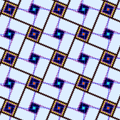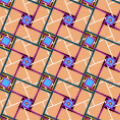File:Countless squares - an example of Pythagorean tiling.svg

Original file (SVG file, nominally 600 × 600 pixels, file size: 2 KB)
Captions
Captions
Summary edit
| DescriptionCountless squares - an example of Pythagorean tiling.svg |
English:
Five drawings of tilings are overlaid. Out of the five, three tilings are similar. Their lines are all inclined at 22.5 or 67.5 degrees. In the last table, below, the first rows give codes of these three colors in CSS. This language is valid here, in the source code of this description, or elsewhere in the SVG code of the image. Here are these line colors in a first table.
Each tiling covers entirely the Euclidean plane by squares of two different sizes. By any edge, any of its tiles adjoins exactly one tile of the other size. Called "Pythagorean tiling" on Wikipedia, such a tiling is necessarily periodic. More precisely, the group of all translations that transform the tiling into itself is generated by a pair of translations through equal distances in perpendicular directions. This pair determines the dimension and orientation of any minimal repetitive pattern of the tiling. You will see such minimal patterns in other images: To make more accessible the SVG code
Edge color Relative coordinates of 'lineTo' Size ratio Minimal patterns
A small edge A large edge Slope Size
#fff 58,-24 58,140 √2 – 1 0 164
#200 -116,-48 -116,280 √2 – 1 0 328
#94a 82, 34 -82,198 √2 – 1 1 164 √2
#f42 52, 30 -112,194 2 – √3 1 164 √2
#24f 20, 16 -144,180 1 / 9 1 164 √2Français : Cinq dessins de pavages sont superposés. Sur les cinq, trois pavages sont semblables. Leurs lignes sont toutes inclinées à 22.5 ou 67.5 degrés. Dans le dernier tableau, ci-dessous, les premières lignes donnent les codes de ces trois couleurs en CSS. Ce langage est valable ici, dans le code source de cette description, ou ailleurs dans le code source de l’image SVG. Voici ces couleurs de ligne dans un premier tableau.
Chaque pavage couvre entièrement le plan euclidien par des carrés de deux tailles différentes. De n’importe quel côté, n’importe quel carreau jouxte exactement un carreau de l’autre taille. Appelé "pavage de Pythagore" dans Wikipedia en anglais, un tel pavage est nécessairement périodique. Plus précisément, le groupe de toutes les translations qui transforment le pavage en lui-même est engendré par une paire de translations sur des distances égales dans des directions perpendiculaires. Cette paire détermine la dimension et l’orientation de n’importe quel motif répétitif minimal du pavage. Vous verrez de tels motifs minimaux dans d’autres images : Afin de rendre plus accessible le code SVG Couleur Coordonnées relatives de 'lineTo' Rapport Motifs minimaux d’un côté Un petit côté Un grand côté des tailles Pente Dimension #fff 58,-24 58,140 √2 – 1 0 164 #200 -116,-48 -116,280 √2 – 1 0 328 #94a 82, 34 -82,198 √2 – 1 1 164 √2 #f42 52, 30 -112,194 2 – √3 1 164 √2 #24f 20, 16 -144,180 1 / 9 1 164 √2 |
||||||||||||||||
| Date | |||||||||||||||||
| Source | Own work | ||||||||||||||||
| Author | Baelde | ||||||||||||||||
| Other versions |
|
||||||||||||||||
| SVG development InfoField | This /Baelde was created with a text editor. |
Licensing edit
- You are free:
- to share – to copy, distribute and transmit the work
- to remix – to adapt the work
- Under the following conditions:
- attribution – You must give appropriate credit, provide a link to the license, and indicate if changes were made. You may do so in any reasonable manner, but not in any way that suggests the licensor endorses you or your use.
- share alike – If you remix, transform, or build upon the material, you must distribute your contributions under the same or compatible license as the original.
File history
Click on a date/time to view the file as it appeared at that time.
| Date/Time | Thumbnail | Dimensions | User | Comment | |
|---|---|---|---|---|---|
| current | 10:52, 11 March 2013 |  | 600 × 600 (2 KB) | Baelde (talk | contribs) | User created page with UploadWizard |
You cannot overwrite this file.
File usage on Commons
The following 6 pages use this file:
Metadata
This file contains additional information such as Exif metadata which may have been added by the digital camera, scanner, or software program used to create or digitize it. If the file has been modified from its original state, some details such as the timestamp may not fully reflect those of the original file. The timestamp is only as accurate as the clock in the camera, and it may be completely wrong.
| Width | 600 |
|---|---|
| Height | 600 |








